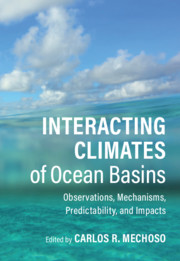Book contents
- Interacting Climates of Ocean Basins
- Interacting Climates of Ocean Basins
- Copyright page
- Contents
- Contributors
- Preface
- 1 Variability of the Oceans
- 2 Teleconnections in the Atmosphere
- 3 Atmosphere–Ocean Interactions
- 4 Interacting Interannual Variability of the Pacific and Atlantic Oceans
- 5 Indian Ocean Variability and Interactions
- 6 The Arctic Mediterranean
- 7 Combined Oceanic Influences on Continental Climates
- 8 Basin Interactions and Predictability
- 9 Climate Change and Impacts on Variability and Interactions
- Index
- References
5 - Indian Ocean Variability and Interactions
Published online by Cambridge University Press: 13 January 2021
- Interacting Climates of Ocean Basins
- Interacting Climates of Ocean Basins
- Copyright page
- Contents
- Contributors
- Preface
- 1 Variability of the Oceans
- 2 Teleconnections in the Atmosphere
- 3 Atmosphere–Ocean Interactions
- 4 Interacting Interannual Variability of the Pacific and Atlantic Oceans
- 5 Indian Ocean Variability and Interactions
- 6 The Arctic Mediterranean
- 7 Combined Oceanic Influences on Continental Climates
- 8 Basin Interactions and Predictability
- 9 Climate Change and Impacts on Variability and Interactions
- Index
- References
Summary
This chapter revisits the variability of the Indian Ocean on interannual to multidecadal timescales. A special focus is given to teleconnections from and to the Indian Ocean and to what extend they modify the Indian Ocean as well as the variability in other oceans. Decadal changes of interannual teleconnections are briefly discussed. Both atmospheric and oceanic pathways for the teleconnections are considered. While the main mode of variability in the Indian Ocean, the basin mode, is mainly externally forced by a teleconnection from ENSO, the second mode of Indian Ocean variability, the Indian Ocean Dipole, is to a large extent an unforced mode of variability. The Indian Ocean can modulate Pacific and, in particular, ENSO variability through oceanic (Indian Ocean Throughflow) and atmospheric (Walker circulation) bridges. The Atlantic Ocean has a modest impact on Indian Ocean interannual variability, mainly in boreal summer. The Indian Ocean is directly connected to the Atlantic Ocean through the Agulhas Current system. At decadal timescales, both Pacific Decadal Variability (Pacific Decadal Oscillation, Interdecadal Pacific Oscillation) and the Atlantic Multidecadal Variability impact the Indian Ocean. While Pacific Decadal Variability influences the Indian Ocean throughout the year, the Atlantic Multidecadal Variability influence is seasonally dependent and strongest in boreal spring season and may have contributed to an accelerated Arabian Sea warming in the recent decades. The Pacific interannual teleconnection to the Indian Ocean shows substantial decadal variations, but further research in this area is necessary and encouraged.
- Type
- Chapter
- Information
- Interacting Climates of Ocean BasinsObservations, Mechanisms, Predictability, and Impacts, pp. 153 - 185Publisher: Cambridge University PressPrint publication year: 2020
References
- 2
- Cited by



